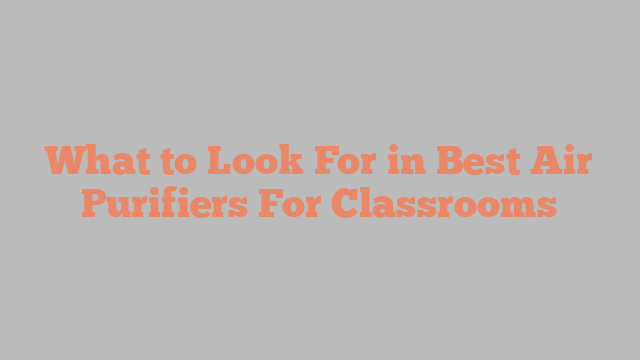Best Air Purifiers For Classrooms
The best air purifiers for classrooms are going to give your kids the information you need to properly purify the air in your kid’s school. Improving indoor air quality in public schools is an extremely important topic. This is simply because so many of them spend so much of their time inside of the classroom, and consequently, they suffer most of their lives from airborne infections that could be alleviated through proper, clean air. However, there are some purifiers out there that don’t live up to their claims. Here is what you want to look for when purchasing an air cleaner for your kids’ room.
HEPA filters are the most common type used by consumers. They are affordable, very efficient, and make sure that nearly all the allergens found in the air are filtered out. While most people think that a HEPA filter is the best way to go, a better option would be to get an electrostatic filter. This type of filter only targets a specific type of allergens and is less expensive and more efficient than a typical HEPA filter.
Camfil Report on Air Purifiers for Schools – Facts You Need to Know
If you’re going to look for an air filter for your classrooms, be sure that it has multiple filters. Even though it’s more expensive, it’s going to be cheaper to replace. Also, be sure that you get an air filter that works well with ductless air cleaners. Ductless air filters only work with traditional air filters and are inefficient when dealing with larger particles like pollen, mold, and bacteria. Look for an air filtration system that works great with ductless units as well.

What to Look For in Best Air Purifiers For Classrooms
Something that you may notice on the market today is air purifying systems that use a variety of different technologies. There are ionizers and mechanical filters. Ionizing air purifiers use positively charged ions to trap and eliminate particles, including those that have a negative charge. Mechanical air filters use a fan to constantly circulate the air, removing larger particles. These technologies all work very well, but ionizing and mechanical filters can cost quite a bit more than other types.
One important thing to look for in an air purifier is whether or not it uses a vital 100% natural filter. A vital 100% natural filter removes all viruses, germs, bacteria, chemicals, cysts, and dust mites from the air that passes through the purifier. For example, if you buy an air purifier that uses a carbon filter and ionization technology, this carbon filter will remove anything that could possibly be harmful to your child. However, a vital 100% filter completely eliminates all viruses and other particles from the room. This alone can save your children’s lives if there is ever a serious illness or chemical poisoning in the home.
Something else to look for when purchasing an air purifier for use in classrooms is one with a sfusd rating. An sfusd rating is what indicates the effectiveness of the machine in reducing the amount of airborne particles that pass through the system. An sfusd rating of two or better indicates that the machine is capable of reducing virtually all particles that pass through. However, an air purifier that uses an sfusd rating that is less than two is not effective at all in reducing the amount of airborne pollutants that are present in classrooms. This means that you may want to find a portable air cleaners that actually utilizes HEPA technology rather than only using activated carbon or ionization technology.
